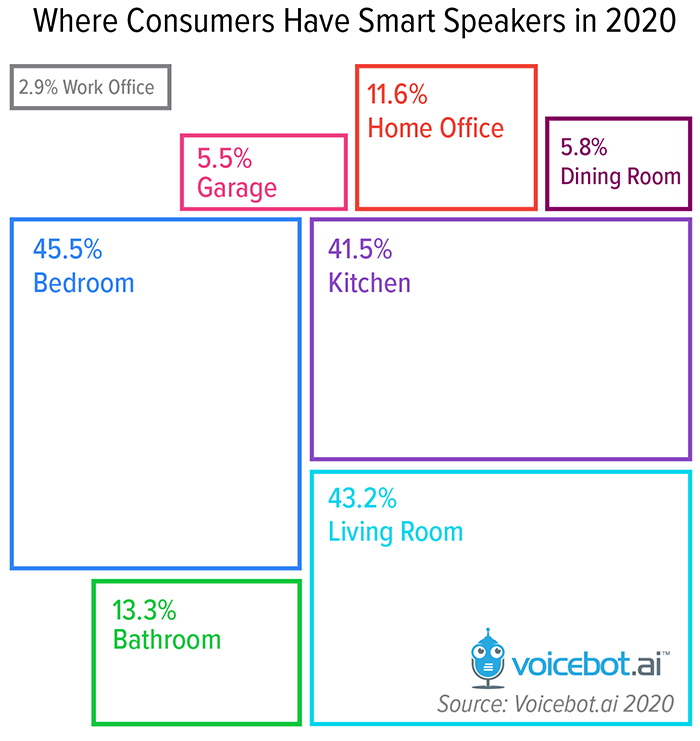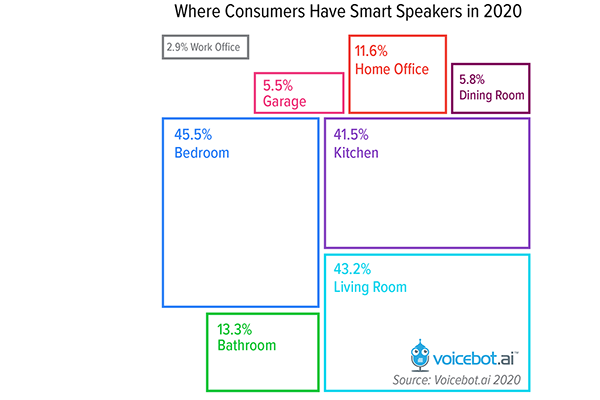Yes. The Bedroom is Now the Most Popular Location for Smart Speakers. Here’s Why and What it Means.
- Smart speakers are most likely to be found in bedrooms, leading other locations in the home at 45.5% of device owners
- The popularity of the bedroom rose about eight percent over 2019 when it was the choice of 37.6% of smart speaker owners
- Consumers with smart speakers in the bedroom are more active users of smart speakers across a number of use cases
- Data suggests smart speakers are becoming more integrated into morning and evening routines for consumers and that privacy concerns are no more prevalent based on location within the home
A key finding in the recently published Smart Speaker Consumer Adoption Report 2020 is that the bedroom is now the king of smart speaker land–if you have more than one device in the home. In January 2020, 45.5% of smart speaker owners said they had a device in the bedroom. That compares to 43.2% for the living room and 41.5% for the kitchen, the top two results in 2019 and 2018. The bedroom was the location of choice for only 37.6% of consumers in 2019 and 36.8% in 2018. It has consistently been in the top three locations and appears to be the biggest beneficiary of consumers adding a second or third smart speaker to the home over the past year.

These results come from a survey of more than 1,000 U.S. adults in January 2020. You can download the full report with more than 30 charts and 30 pages of analysis or the executive summary by using the link below.
Download NowThe Leader of the Second Location is First Overall
We wrote recently about data showing a spike in recipe usage on smart speakers under quarantine. That data speaks to the utility of smart speakers (and smart displays) in the kitchen. The living room has been popular from the beginning due to the entertainment features common to smart speakers as well as integration into smart home devices such as televisions and lighting. Those entertainment and smart home integrations surely play into the bedroom as a popular location.
Our analysis shows that the bedroom commands the top spot because it is the most popular second location for a smart speaker. Device owners that have a smart speaker in the living room, kitchen, or bathroom, are more likely to also have one in the bedroom than any other place in the home. However, if a consumer only has a single smart speaker, the bedroom is the third most likely placement following the living room and kitchen. Nearly two-thirds of consumers that have two or more smart speakers have one in the bedroom.
This represents an example where Ricky Bobby is wrong. In the case of smart speaker locations, when you’re second, you’re first.
What the Bedroom Means for Voice App Adoption
Consumers with a device in the bedroom are also significantly more likely to be heavy users of smart speakers for media, news, smart home, and third-party voice apps such as Alexa skills and Google Actions. These users are 21% – 25% more likely to be listening to streaming music, radio, and podcasts on a daily basis than all device owners. They are 27% more likely to be listening to the news daily. This aligns well with entertainment and news services being part of morning and evening consumer routines.
Smart home device use showed an even wider gap. Smart speaker users with a device in the bedroom are 52% more likely to be daily active users of smart home solutions. They are also 37% more likely to have a smart home device in their home.
Third-party voice apps saw a similar correlation. If you have a smart speaker in the bedroom you are 24% more likely to have tried a third-party voice app and 58% more likely to be a daily user of these services.
These correlations are logical. If you have a smart speaker in the bedroom you are more likely to have multiple devices in the home which means you have decided they provide enough value to extend the convenience to multiple locations. This also means you are more likely to be using a wider array of smart speaker features more frequently.
Beyond this, there is an insight for first and third-party voice app developers. The bedroom is increasingly a location where consumers have smart speakers. They may benefit from tailoring their use cases to morning and evening routines or create new experiences designed to support bedroom-based use cases. I will let your imagination take it from there.
Privacy Concerns are General and Not Specific
A final point worth mentioning is that the rising presence of smart speakers in the bedroom suggests that privacy concerns around the devices are generalized and not specific. Consumers are not behaving as if their concerns about smart speakers are lesser in a general living area than in their bedroom where privacy is generally thought to be at a premium. In fact, if you have a smart speaker in the bedroom, you are equally likely to be unconcerned about the privacy risk posed by the devices as the general public including those that don’t own smart speakers.
Consumers have assessed the risks and either believe intrusion on their privacy is a low likelihood event or that the protections offered by smart speaker makers provide a reasonable level of protection.
Follow @bretkinsella Follow @voicebotai
Introducing Voicebot Research – The Most Comprehensive Data on Voice Assistants and AI
Nearly 90 Million U.S. Adults Have Smart Speakers, Adoption Now Exceeds One-Third of Consumers









